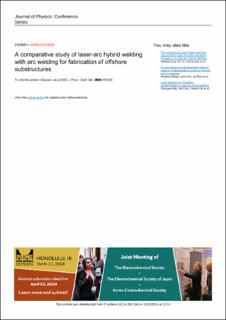| dc.contributor.author | Bunaziv, Ivan | |
| dc.contributor.author | Ren, Xiaobo | |
| dc.contributor.author | Olden, Vigdis | |
| dc.date.accessioned | 2024-04-11T12:35:07Z | |
| dc.date.available | 2024-04-11T12:35:07Z | |
| dc.date.created | 2023-11-07T10:57:20Z | |
| dc.date.issued | 2023 | |
| dc.identifier.citation | Journal of Physics: Conference Series (JPCS). 2023, 2626: 012033 . | en_US |
| dc.identifier.issn | 1742-6588 | |
| dc.identifier.uri | https://hdl.handle.net/11250/3126122 | |
| dc.description.abstract | Laser-arc hybrid welding (LAHW) is an efficient and promising joining method for offshore structures made from metallic alloys. Under a high-power laser output, a keyhole is formed that efficiently melts a metal and provides high penetration depths compared to shallow and wide welds made by conventional arc welding, thus it requires much less time for production. A significant reduction in welding time leads to a substantial reduction of welding consumables and electricity use. Higher gap bridging ability can be achieved and tolerances for plate preparation is reduced when an arc is added to a laser beam. This work explicitly presents and compares different welding methods and their efficiency in application for offshore windmill substructures. According to a preliminary calculation, LAHW may reduce welding time by 10–20 times depending on process parameters and up to 15 times lower consumables usage. It was identified that the highest costs in welding is the filler wire followed by a shielding gas and electricity. This leads to high efficiency of LAHW in term of sustainability and reduction of CO2 emissions in general compared to well-established arc welding. However, the narrow and deep welds made by LAHW may suffer from high hardness in the root area, inhomogeneous filler metal mixing, which may lead to poor microstructure, cracking and porosity. This requires an extensive research work on the process optimization and understanding the underlying physics to provide sound welds which must comply with the international standards. | en_US |
| dc.language.iso | eng | en_US |
| dc.publisher | IOP Publishing | en_US |
| dc.rights | Navngivelse 4.0 Internasjonal | * |
| dc.rights.uri | http://creativecommons.org/licenses/by/4.0/deed.no | * |
| dc.title | A comparative study of laser-arc hybrid welding with arc welding for fabrication of offshore substructures | en_US |
| dc.title.alternative | A comparative study of laser-arc hybrid welding with arc welding for fabrication of offshore substructures | en_US |
| dc.type | Peer reviewed | en_US |
| dc.type | Journal article | en_US |
| dc.description.version | publishedVersion | en_US |
| dc.rights.holder | Published by IOP Publishing under a CC-BY license. | en_US |
| dc.source.pagenumber | 10 | en_US |
| dc.source.volume | 2626 | en_US |
| dc.source.journal | Journal of Physics: Conference Series (JPCS) | en_US |
| dc.identifier.doi | 10.1088/1742-6596/2626/1/012033 | |
| dc.identifier.cristin | 2193113 | |
| dc.relation.project | Norges forskningsråd: 321954 | en_US |
| dc.relation.project | Norges forskningsråd: 309584 | en_US |
| dc.relation.project | Norges forskningsråd: 269898 | en_US |
| dc.source.articlenumber | 012033 | en_US |
| cristin.ispublished | true | |
| cristin.fulltext | original | |
| cristin.qualitycode | 1 | |

